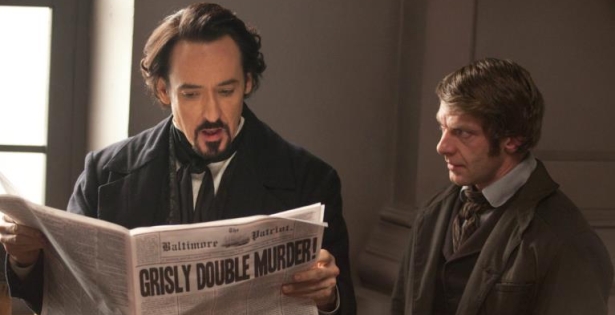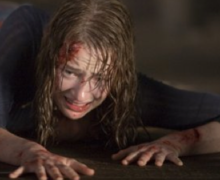The long-gone author who inspired The Raven has 251 movie- or TV-writing credits and counting.
The Raven isn't based on an Edgar Allan Poe story—it's based on the idea of people being obsessed with Edgar Allan Poe stories. The film, out Friday, stars John Cusack as Poe, who's been recruited by a police detective to solve a series of murders based on the author's bloodiest tales. Quoth The Raven's poster, "The only one who can stop a serial killer is the man who inspired him."
But the works of Poe have inspired many men besides The Raven's serial killer. Edgar Allan Poe remains one of the few writers to have fully pervaded America's pop-culture consciousness. His legacy can be seen everywhere, from professional wrestling to the NFL, and references to his works have appeared in unlikely places that span from full-length concept albums by The Alan Parsons Project and Lou Reed to a series of Batman comic books. But Poe's primary pop-culture legacy has been on film and television. At present, Edgar Allan Poe has 251 "writing" credits on the Internet Movie Database. Pretty good for a man who died in 1849, nearly 50 years before the invention of the motion picture.
Story continues below.
It's easy to see why Poe has been a continuous source of inspiration to filmmakers. His best-known stories are laden with macabre, feverish imagery that pops off the screen, and he pioneered the twist ending more than 100 years before imitators like M. Night Shyamalan. Perhaps best of all, his works are old enough to be in the public domain, so any filmmaker can adapt any of his stories for free (it's for this reason that film festivals—and YouTube—are littered with amateur Poe shorts).
But Poe adaptations also face considerable challenges. Many of his stories were controversial in their time and remain unsettling to audiences today. What's more, his best-known and most commonly adapted works—"The Fall of the House of Usher," "The Tell-Tale Heart," and "The Raven"—are extremely short. There's simply not enough content in the original texts for a feature-length movie, which means that any feature-length Poe film has to be padded with newly invented material. This formula has led to some strong films, including 1932's disturbing Murders in the Rue Morgue and 1961's Roger Corman-helmed The Pit and the Pendulum—the second (and best) of the filmmaker's five-year string of Poe adaptations. But those are good films, not good Poe films. They may contain echoes of Poe's greatest works, but his singular voice and straightforward, skin-crawling stories resist expansion or alteration.
MORE ON MOVIES
That's why the best Poe adaptations, by far, are the ones that sit back and allow Poe's voice to take center stage. A 1953 animated short version of The Tell-Tale Heart, which eventually earned an Oscar nomination, was unsettling enough that the British Board of Film Censors gave it an "X" rating—the first ever for a cartoon. Long before her work on film and stage made her a household name, Julie Taymor offered a brilliant short adaptation of Poe's underappreciated "Hop-Frog." And one of the all-time best Poe adaptations comes from an unlikely source: the first installment in The Simpsons' annual Halloween episode, which offers a surprisingly faithful take on The Raven and stars Homer as the narrator and Bart as the bird. And for anyone who wants the authentic Poe experience, it's not hard to enjoy the most literal adaptation imaginable, dramatic readings of his original texts (YouTube offers a grab-bag of terrific takes on The Raven, including versions by Vincent Price, James Earl Jones, and Christopher Walken.)
But I'd argue the best Poe adaptation of all time come from an even less expected source than The Simpsons: an out-of-print 1995 computer game called The Dark Eye, which allowed players to experience stories including "The Tell-Tale Heart," "The Cask of Amontillado," and "Berenice" through the eyes of both murderer and victim. Animated with grotesque puppets and narrated by author William S. Burroughs, The Dark Eye uses the genre's interactivity to do what even the best of Poe's film and TV adaptations couldn't. It offers a completely unique new perspective on the 150-year-old stories while managing to remain entirely faithful to them.
If current reviews are any indication, Poe fans should set their expectations for The Raven a good deal lower. The Raven can hardly be called a faithful adaptation of Edgar Allan Poe's work, but it is, in its own way, a faithful adaptation of "Edgar Allan Poe"—less a writer and more an idea that has haunted our movie theaters, TV screens, and imaginations for decades. That's how it should be. The author who struggled all his life to earn enough by writing achieved, in death, a career and legacy he could never have imagined. It's a twist ending that a less cynical Poe might have written—and, perhaps, one he would have appreciated.
We want to hear what you think about this article. Submit a letter to the editor or write to letters@theatlantic.com.





